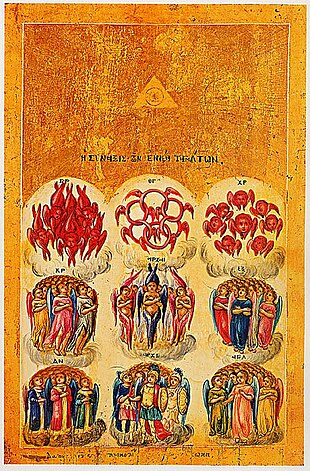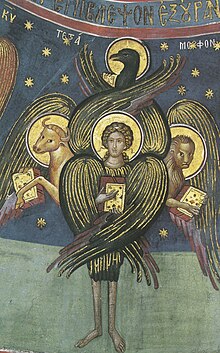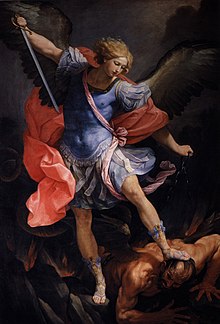



InChristianity, angels are the messengers of God.
This section needs expansion with: A general view of angels according to Christians in Antiquity. You can help by adding to it. (February 2023)
|
In chapter V of Ignatius of Antioch's Letter to the Trallians, the bishop gives a listing of angels not unlike that later proposed by Pseudo-Dionysius. In his First Epistle of Clement, Clement of Rome exhorts his listeners to join the angels in praising God. Clement of Alexandria wrote that angels “breathe” in men’s thoughts and reasonings, and “puts in” their hearts “strength” and a keener perception.[1] Evagrius Ponticus spoke of the concept of angelic companions and angels as models for behavior.[2]
Augustine of Hippo remarks, the angels were experiencing something new as the creation of God unfolded.[3] Augustine also considers that the 'good' angels seek at all times, to direct us towards the true source of happiness, God; that they encourage us in worship of God.[4]
According to Pseudo-Dionysius the Areopagite's De Coelesti Hierarchia (On the Celestial Hierarchy), there are three levels ("sphere") of angels, inside each of which there are three orders.
Various works of Christian theology have devised hierarchies of angelic beings. The most influential Christian angelic hierarchy was put forward around the turn of the 6th century CE by Pseudo-Dionysius in his work De Coelesti Hierarchia. He claimed to be an important figure who was converted by Paul the Apostle, and the Pseudo-Dionysius enjoyed greater influence than it would have if he had used his actual name, until Erasmus publicised doubts about the age of the work in the early 16th century.[5]
According to the Catechism of the Catholic Church (CCC) paragraph 328, "the existence of the spiritual, non-corporeal beings that Sacred Scripture usually calls 'angels' is a truth of faith. The witness of Scripture is as clear as the unanimity of Tradition."[6] The same catechism states: "The whole life of the church benefits from the mysterious and powerful help of the angels [...] From its beginning until death, human life is surrounded by their watchful care and intercession."[7] It also states, "Christ is the center of the angelic world. They are His angels [...] They belong to Him because they were created through and for Him".[8]
Tradition places seraphim in a rank in Christian angelology, based on Isaiah's use of the word. Seraphim angels are the closest to God and lead worship in heaven by singing endless praises to him.[9]

In the Book of Ezekiel, and in some Christian icons, the cherub is depicted as having two pairs of wings, and four faces: that of a lion (representative of all wild animals), an ox (domestic animals), a human (humanity), and an eagle (birds).[10] Their legs were straight, the soles of their feet like the hooves of a bull, gleaming like polished brass. Later tradition ascribes to them a variety of physical appearances.[10] In Western Christian tradition, cherubim have become associated with the putto (derived from classical Cupid/Eros), resulting in depictions of cherubim as small, plump, winged boys.[11]
The ophanim refer to the wheels seen in Ezekiel's vision of the chariot (Hebrew merkabah) in Ezekiel 1:15–21. One of the Dead Sea scrolls (4Q405) construes them as angels.[12]

The Dominions (lat. dominatio, plural dominationes, also translated from the Greek term kyriotētes, pl.ofkyriotēs, as "Lordships").[13] Traditionally, they are held to govern the movement of stars, planets, and other celestial objects.[14]
According to The Etymologies of Isidore of Seville, the Virtues are known for their control of the elements. In addition to being the spirits of motion, they also assist in governing elements of nature, such as storms.[14] They also assist with miracles, as well as encourage humans to strengthen their faith in God.[15]
InThe Etymologies of Isidore of Seville, the Powers (lat. potestas (f), pl. potestates) (Greek: ἐξουσίαι) are given their name because they are angels who have power over evil forces, which the angels are able to restrain to keep them from doing harm.[15] Powers also oversee the power which human beings—such as kings—have been given in the world.[14]
According to The Etymologies of Isidore of Seville, the Principalities (Latin: principatus), also translated as "Princedoms" and "Rulers", from the Greek archai, pl.ofarchē (see Greek root in Eph 3:10), are the angels that guide and protect nations, or groups of peoples, and institutions such as the Church. The Principalities preside over the bands of angels and charge them with fulfilling the divine ministry. There are some who administer and some who assist.[15][needs update]
An example of a Principality angel that is the subject of cult is the Angel of Portugal.

The word archangel is only used twice in the New Testament: in 1 Thessalonians 4:16 and Jude 1:9.
In most Christian traditions, Gabriel is also considered an archangel, but there is no direct literary support for this assumption. The term archangel appears only in the singular, never plural, and only in specific reference to Michael.
The name of the archangel Raphael appears only in the Book of Tobit (Tobias).
The Holy See's 2001 Directory on popular piety states: "The practice of assigning names to the Holy Angels should be discouraged, except in the cases of Gabriel, Raphael and Michael whose names are contained in Holy Scripture".[16]
A guardian angel is a type of angel that is assigned to protect and guide a particular person, group or nation. Belief in tutelary beings can be traced throughout all antiquity. The idea of angels that guard over people played a major role in Ancient Judaism. In Christianity, the hierarchy of angels was extensively developed in the 5th century by Pseudo-Dionysius the Areopagite. The theology of angels and tutelary spirits has undergone many changes since the 5th century. The belief is that guardian angels serve to protect whichever person God assigns them to.
|
| |||||
|---|---|---|---|---|---|
| Angels in Judaism |
| ||||
| Angels in Christianity |
| ||||
| Angels in Islam |
| ||||
| Uthras (angels) in Mandaeism |
| ||||
| Related |
| ||||
| In culture |
| ||||